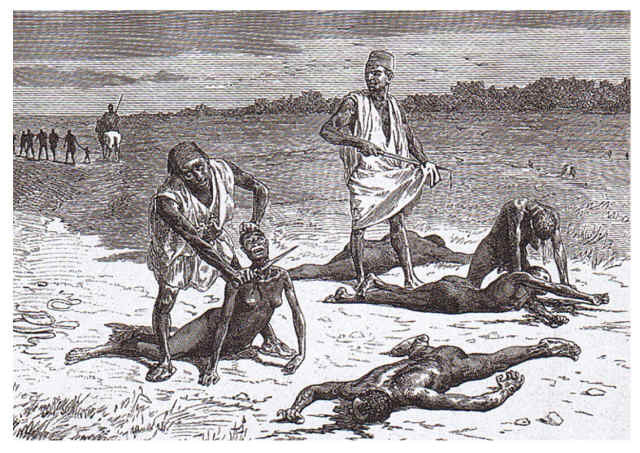
2. Central North-South Route – Internal Trade to Coastal Forts
Regions Involved: Ashanti, Bono, Akyem, Gonja → Cape Coast, Elmina, Anomabo
Purpose: Supplying European traders on the coast
Traders: Asante, Denkyira, Fante, Wassa, Akwamu
Captured From: Internal wars, raids, debt slavery
Kingdoms like the Asante Empire became military and economic powers through constant expansion, supplying war captives to European buyers. The main slave caravan routes carried captives from Kintampo, Kumasi, and Techiman to Cape Coast Castle and Elmina Castle, where they were imprisoned before being shipped to the Americas.
3. Eastern Route – Volta and Danish Forts
Regions: Krobo, Anlo-Ewe, Akwamu → Keta, Ada, Accra (Christiansborg)
Destination: Danish, Portuguese, and British forts
Key Sites: Fort Prinzenstein (Keta), Fort Kongenstein (Ada Foah)
This eastern corridor connected present-day Togo and eastern Ghana. The Ewe and Akwamu kingdoms were both traders and sometimes victims. The Danes, who built Christiansborg Castle (Osu Castle) in Accra, were deeply involved in the trade here.
4. Coastal Fort Network – West Africa’s Slave Coast
Main Ports: Elmina, Cape Coast, Anomabo, Dixcove, Keta, Accra
European Powers: Portuguese, Dutch, British, Danes, Swedes
Role: Fortresses where slaves were held, sold, and shipped to the Americas
Ghana alone has over 30 surviving slave forts and castles — more than any other African country — marking it as the epicenter of the trade on the Slave Coast of West Africa.
African Kingdoms That Participated in the Slave Trade
Many African kingdoms supplied captives to European traders, often captured through war or raids:
| Kingdom | Region (Modern Ghana) | Role in Trade |
|---|---|---|
| Asante Empire | Ashanti, Bono, Brong | Major exporter of slaves via wars |
| Denkyira | Central / Ashanti | Early coastal trader before defeat by Asante |
| Fante Confederacy | Central coast | Middlemen between Asante and Europeans |
| Akyem & Akwamu | Eastern Region | Fighters and traders of captives |
| Gonja & Dagbon | North & Savannah | Supplied slaves to southern and trans-Saharan trade |
| Anlo-Ewe States | Volta Region | Some engaged with European forts; others raided |
Key Slave Heritage Sites to Visit in Ghana
1. Cape Coast Castle
Built by: Swedes (1653), later controlled by British
Significance: Major British hub for slave exports
Highlights: Door of No Return, dungeons, museum
2. Elmina Castle
Built by: Portuguese (1482) — oldest European building in sub-Saharan Africa
Significance: Key fort for Portuguese and later Dutch slave trade
Highlights: Governor’s quarters, female slave dungeons, chapel
3. Fort Amsterdam (Abandze)
Used by: English and Dutch
Known for: Brutal conditions and female exploitation
4. Christiansborg Castle (Osu, Accra)
Built by: Danes
Later Used As: Seat of Ghana’s colonial and independent governments
Note: Slave history here is less accessible but being rediscovered
5. Fort Prinzenstein (Keta)
Built by: Danes
Now: A crumbling fort with haunting views of the Atlantic
6. Assin Manso Slave River
Purpose: The last bathing point for slaves before reaching the coast
Now: A memorial and spiritual site
7. Fort William (Anomabo)
Built by: Originally by the Dutch, expanded by the British in the 18th century
Significance: One of the largest British slave forts in West Africa; possibly exported more slaves than Cape Coast in its peak years
Known For: Massive underground dungeons, terrifying holding conditions, direct British trade connections
Today: Partially restored, it stands as a sobering reminder of Anomabo's role in the slave economy
Why This History Matters Today
Understanding Ghana’s role in the transatlantic slave trade is essential for:
African diaspora visitors retracing their roots
Students and researchers exploring African history
Ghanaians reflecting on the legacy of their ancestors
Tourists who want to engage with more than beaches and wildlife
This is a story of pain, betrayal, resistance, and survival. While Europeans profited enormously from enslaving Africans, some local African elites were also complicit. Others resisted or were victims of empire-building wars.
Remembering this history helps foster understanding, justice, and healing — especially for the African diaspora across the Americas and the Caribbean.
Ghana Today: Honoring the Past, Welcoming the World
Ghana has positioned itself as a place of remembrance and return. In 2019, the country launched the "Year of Return" and continues with initiatives like "Beyond the Return", encouraging descendants of enslaved Africans to reconnect with their ancestral home.
By visiting these sites and learning about the old slave routes and empires, visitors gain a deeper appreciation of Ghana’s resilience, cultural depth, and role in global history.
For Tourists and Educators: Suggested Itinerary
Day 1-2: Accra (Osu Castle, National Museum, James Town)
Day 3-4: Cape Coast Castle & Elmina Castle (Central Region)
Day 5: Assin Manso Slave River (on the way north)
Day 6-7: Kumasi (Manhyia Palace, Asante Museum, royal history)
Optional Extension: Northern Ghana (Dagbon, Mamprugu, and Islamic trade links)
🔚 Final Reflection
Ghana is a place where ancient kingdoms still stand, culture runs deep, and the ocean holds the echoes of untold stories. By walking the same paths once taken by captives, and standing in the dungeons where they waited in fear, you don’t just learn history — you feel it.
Let this journey remind us all: we must never forget, but we must also move forward — informed, connected, and united by truth.